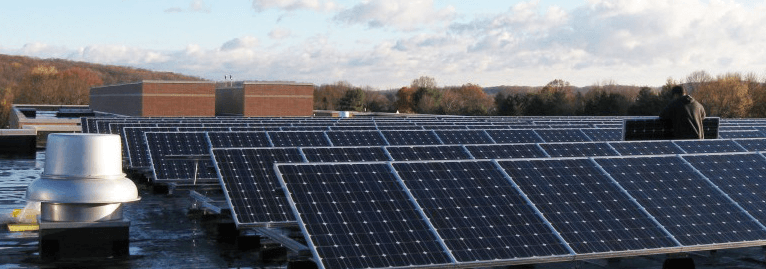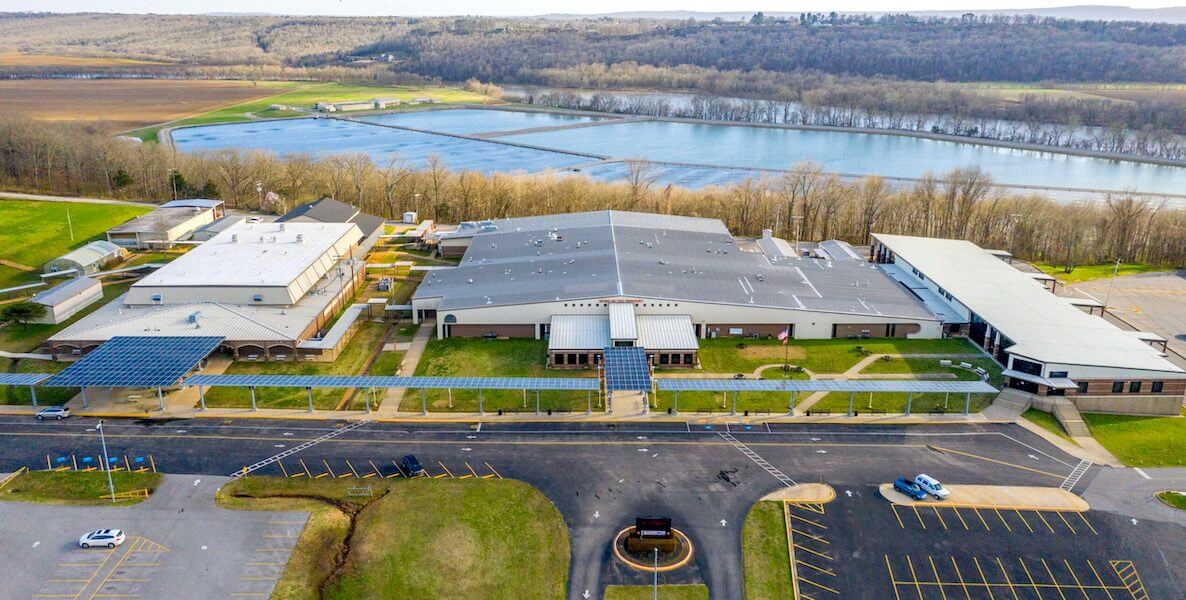The high school in Batesville, Arkansas, home of The Pioneers, looks and feels like many other small-town high schools in America—parking lot in front, a grassy football field in back and a wide one-story building for its 630 students—with one notable, pioneering, exception: The school and its grounds sit decked out in 1,400 shining solar panels.
“It looks like you’re coming into an international airport,” says Dr. Michael Hester, the district’s superintendent since 2017. “It’s beautiful, and kids can look out and see the solar panels and they understand that we’re using technology and innovation.”
This solar array, completed in 2018, was part of Batesville’s comprehensive energy conservation initiative, which stemmed from an effort at the start of Hester’s tenure to be more efficient by, in part, eliminating excess campus facilities and conducting an energy audit. The district partnered with Entegrity, an energy and solar development company, to upgrade lighting to LEDs, install water-saving fixtures, insulate buildings and install the solar panels.
“Our defensive game plan was how to be more efficient, but then all of a sudden there was the prospect of having an offensive game plan: how do you make money,” says Hester.
The savings from the reduced energy costs over the next three years resulted in a budget surplus of $1.8 million. That allowed the district to raise teachers’ salaries an average of $2,000 to $3,000 per year.
“Our defensive game plan was how to be more efficient, but then all of a sudden there was the prospect of having an offensive game plan: how do you make money,” says Hester. “In the last four years, we’ve been able to add around $10,000 to each staffer in pay raises. It just gives us pride.”
Batesville, Arkansas, is a long way from—and a lot smaller than—Philadelphia. And it gets a bit more sun per year than we do here in the Northeast. (Though not enough more to make a major difference.) But it shares with the Philadelphia School District some of the same concerns—including not enough funds. In Philly, despite an infusion of cash from the American Rescue Plan, the district still lacks the money to fix school buildings that are toxic, outdated or otherwise dangerous. School facilities need billions in upgrades and repairs, which means years of slow-going and disruptive work.
But a six-year-old study shows that Philly public schools, which collectively spend about $45 million annually on energy bills, could be leaving money on the table: According to a 2016 Philadelphia Energy Authority report, installing solar panels could save school buildings up to $20,000 in energy expenses each. That’s money that could be used in turn to pay for building renovations or other underfunded programs.
Solar power is on the rise nationally
Over the last decade, the cost of solar panels has declined significantly while the technical expertise and availability of installers has increased, making solar power a much more viable energy source from utility-scale projects to individual households.
\The International Renewable Energy Agency’s Renewable Power Generation Costs in 2020 report, released in June 2021, shows that 62 percent of the world’s renewable energy power is now cheaper than the least expensive fossil fuel energy sources. In the US, the cost of utility-scale solar electricity fell by 85 percent between 2010 and 2020. And the U.S. Energy Information Administration (EIA) estimates that by 2030, solar-generated power will be well below the cost of most fossil fuel energy sources.
Meanwhile, between 2014 and 2020, the number of K through 12 schools in the U.S. using solar power increased by 81 percent, including dozens of school districts in Pennsylvania. Great Valley School District in Chester County used grants to fund a $1 million array atop the Great Valley Middle School that provides up to 25 percent of the school’s power. In Bucks County, Quakertown Community School District installed solar at its high school, which produces 50 percent of the school’s energy needs. And in Montgomery County, Colonial School District installed solar panels at three schools. One of them, Colonial Middle School, gets nearly 100 percent of its power from the sun on a good sunny day.

Philly does not have any solar-powered schools, but it has dived into residential solar energy through Solarize Philly, which in the last six years has connected nearly 750 homeowners with local solar installers, providing discounted installation service while training public school students to work in the industry. (So far, according to the Solarize Philly website, 98 new jobs have been created.)
Solarize Philly is part of The Philadelphia Energy Campaign, launched by PEA and City Council President Darrell Clarke in 2016 as a billion-dollar investment over 10 years in energy efficiency projects, carbon reduction, job training, and more, to create jobs and improve public health through building a clean energy economy. The five-year progress report is due for release shortly, but already, the investments have produced more than 1,300 jobs and nearly $50 million in energy savings.
The PEA, which also works as a technical advisor and supporter of the district’s energy policy, released its Solar Schools report in December 2016 detailing how Philly could implement solar power in its school buildings. The report described the potential costs and benefits of rooftop solar photovoltaic (PV) systems by modeling solar installations and potential power generation for 18 Philadelphia schools.
The average cost of a solar system in the US is currently $2.776 per watt, or $1.388 million for a 500 kW array, before federal solar tax credits and other state incentives. But financing models allow schools to install the panels without much upfront expense or accruing debt. Power purchase agreements (PPA) are where a third-party investor (either a private company or other authorized entity) pays for the installation and technically “owns” the solar panels. The school then contracts to buy the power from the owners for 20 to 25 years, at a cost set below the current price for conventional electricity. A roof lease is similar, except the power purchased is the same price as conventional electricity, and the third party makes payments to the site owner in exchange for the roof space.
According to a 2016 Philadelphia Energy Authority report, installing solar panels could save school buildings up to $20,000 in energy expenses each. That’s money that could be used in turn to pay for building renovations or other underfunded programs.
The report analyzed both financial options, energy prices, and the market for solar renewable energy certificates (SRECs) with and without subsidies using the example of a 500kW solar array generating approximately 600,000 kWh of electricity per year. The best-case scenario was a PPA agreement with subsidized SRECs, resulting in savings in the tens of thousands over 25 years. However, with the recent drastic fluctuations in the energy market, the PEA estimates it is closer to $20,000. A follow-up study commissioned in 2019 analyzed four schools’ electric bills, designed a solar PV layout for their roofs, and determined that rooftop solar could offset approximately 45% of the schools’ energy consumption. As time goes on, the savings from switching to solar increase because fossil fuels are a limited resource, and once the PPA ends, the school’s power comes only at the cost of maintenance.
While a multitude of market variables impact energy prices and complicate price predictions, the PEA concludes that solar would be a worthwhile investment.
“We get more than enough sun for solar to be economically feasible,” says Emily Schapira, president and CEO of PEA. “You don’t get the savings like you see in Arkansas, but you get price parity, and it gives you a really important and solid hedge on future electricity prices.”
How to make solar happen here
Unlike Arkansas, Pennsylvania has historically been an energy-producing state, whether that was coal or natural gas, so energy costs are lower here than they are in other places. Our state is in the middle of the pack as far as cost savings that could be accrued from solar energy. And politically, solar has been a hard sell.
“You can just see how much the policy impacts the feasibility of actually doing,” says Schapira. Still, “The Philly solar market is growing. The more it grows, the cheaper it becomes.”
In Batesville, the school district funded their energy project through a $5.4 million bond issue voted on by the residents. Hester is frank about the legwork involved: “When we did that, we had 32 town hall meetings. We had to close down some schools, and sell the campus back to these little towns or give it to the cities or to a nonprofit. We had to navigate all that, so we had to have a lot of communication to start with.”
Many municipal, state and federal programs are advancing renewable energy through funding and assistance, with the intent to grow the industry. Government agency-sponsored programs and environmental groups offer grants and technical assistance to schools considering solar power, such as the US Green Building Council: Center for Green Schools. The federal solar investment tax credit, first enacted in 2006, was extended to cover any projects started before 2024. It is being “phased down,” meaning that this year the credit was 26 percent, next year it will be 22 percent, and by 2024, it will be just 10 percent for commercial and utility-scale. Time is of the essence.
This could be the best moment to start down the path of solar-powered savings for schools. Already, Schapira says, the district has enacted deep energy refits that have made school buildings far more energy efficient, with another round of refits in process. Now the school district has launched a call for input from the public as it formulates its latest capital improvement plan, giving parents and families a chance to weigh in on priorities over the next few weeks. That comes as the District has been allotted $1.1 billion in Covid relief funds, much of which is destined to be used for much-needed renovations.
Could some portion of the funds be used to install solar panels on a school roof already scheduled for work? That could be a way to test how much savings really accrue, and how those savings could be reinvested into further renovations within the school. Perhaps the District could even use the project as hands-on experience for students in Frankford High School’s Bright Solar Futures Academy, which opened in the fall of 2020, to train students for work in the solar industry.
The pieces are almost all there. Taking the next step requires a shift in priorities towards long-term thinking.
 The Citizen is one of 20 news organizations producing Broke in Philly, a collaborative reporting project on solutions to poverty and the city’s push towards economic mobility. Follow the project on Twitter @BrokeInPhilly.
The Citizen is one of 20 news organizations producing Broke in Philly, a collaborative reporting project on solutions to poverty and the city’s push towards economic mobility. Follow the project on Twitter @BrokeInPhilly.
![]() RELATED STORIES ABOUT CLIMATE ACTION AND SUSTAINABILITY FROM THE CITIZEN
RELATED STORIES ABOUT CLIMATE ACTION AND SUSTAINABILITY FROM THE CITIZEN
Header photo of Batesville High School courtesy of Batesville School District



